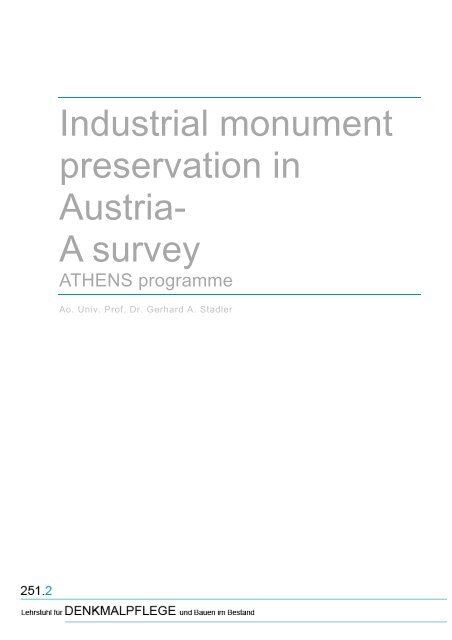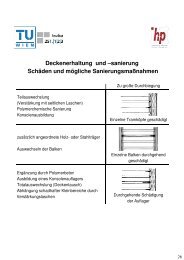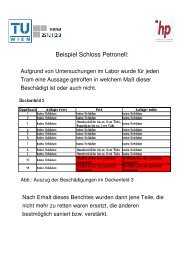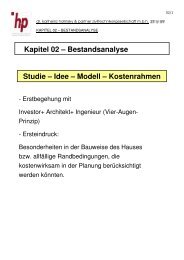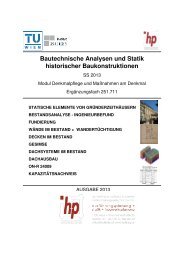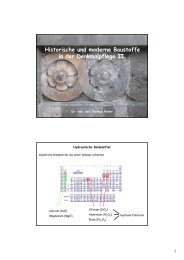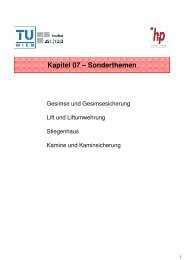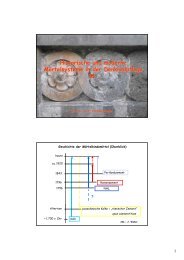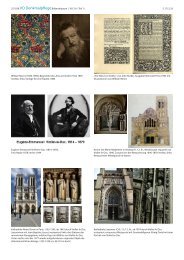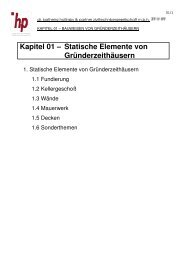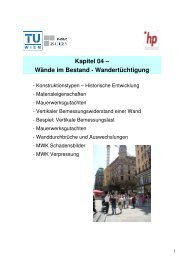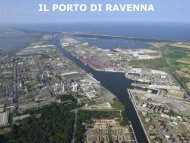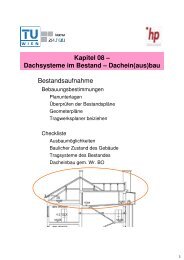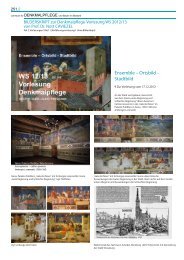Industrial monument preservation in Austria- A survey - Denkmalpflege
Industrial monument preservation in Austria- A survey - Denkmalpflege
Industrial monument preservation in Austria- A survey - Denkmalpflege
You also want an ePaper? Increase the reach of your titles
YUMPU automatically turns print PDFs into web optimized ePapers that Google loves.
<strong>Industrial</strong> <strong>monument</strong><br />
<strong>preservation</strong> <strong>in</strong><br />
<strong>Austria</strong>-<br />
A <strong>survey</strong><br />
ATHENS programme<br />
Ao. Univ. Prof. Dr. Gerhard A. Stadler
The beg<strong>in</strong>n<strong>in</strong>gs of <strong>in</strong>dustrial <strong>monument</strong> <strong>preservation</strong> <strong>in</strong> <strong>Austria</strong> date back to the early days of the<br />
First Republic. The Federal Act for Monument Preservation was adopted <strong>in</strong> 1923 and created the<br />
basis for the comprehensive protection of <strong>monument</strong>s, <strong>in</strong>clud<strong>in</strong>g technical <strong>monument</strong>s. In addition,<br />
<strong>in</strong> 1925, a separate department was set up with responsibility for <strong>in</strong>dustrial history and technical<br />
<strong>monument</strong>s under the direction of the head of the Numismatic Department, August Loehr.<br />
A key object <strong>in</strong> the focus on technical <strong>monument</strong>s proved to be Wheel Mill (“Radwerk”) number IV<br />
<strong>in</strong> Vordernberg / Styria. Vordernberg had been a centre of iron smelt<strong>in</strong>g on the Styrian Erzberg<br />
s<strong>in</strong>ce the 15 th century, and consisted of 14 ironworks, which were numbered along the course of the<br />
Vordernberg Stream and referred to as “wheel mills” after the water wheels used to drive the<br />
bellows. When the enterprise, the <strong>Austria</strong>n-Alp<strong>in</strong>e M<strong>in</strong><strong>in</strong>g und Iron Works Company concentrated<br />
crude iron production at the Donawitz and Eisenerz works, the Vordernberg wheel mills ceased to<br />
have any useful value. In 1928, Wheel Mill number IV, constructed <strong>in</strong> 1846, was placed under<br />
protection as the first technical <strong>monument</strong> <strong>in</strong> <strong>Austria</strong>.<br />
In addition, the <strong>monument</strong> <strong>preservation</strong> experts also turned their attention to old bridge structures,<br />
the horse-drawn railways, weir and lock systems, water mills and w<strong>in</strong>dmills, glass works, potteries<br />
and stove mak<strong>in</strong>g workshops, the textile and the brew<strong>in</strong>g <strong>in</strong>dustries as well as the Augarten<br />
Porcela<strong>in</strong> Factory.<br />
This successful era of <strong>in</strong>dustrial <strong>monument</strong> <strong>preservation</strong> <strong>in</strong> the 1920s and 1930s was rudely<br />
<strong>in</strong>terrupted by the events and effects of the war. Although even dur<strong>in</strong>g the first years of the war<br />
important witnesses to iron smelt<strong>in</strong>g <strong>in</strong> Car<strong>in</strong>thia were placed under protection, namely the fluid<br />
furnaces at Löll<strong>in</strong>g and <strong>in</strong> the Urtlgraben district <strong>in</strong> 1939, followed by the blast furnace at Hirt <strong>in</strong><br />
1941.<br />
The devastat<strong>in</strong>g effects of the Second World War led to a last<strong>in</strong>g and ultimately decade-long<br />
<strong>in</strong>terruption to <strong>in</strong>dustrial <strong>monument</strong> <strong>preservation</strong> activities <strong>in</strong> <strong>Austria</strong>. The fact that there was no<br />
time to secure or document <strong>in</strong>dustrial <strong>monument</strong>s <strong>in</strong> the years of national post-war reconstruction<br />
was above all due to the concentration of <strong>preservation</strong> work on the <strong>in</strong>ventory of traditional<br />
<strong>monument</strong>s. In addition, after August Loehr’s retirement, the Department for Historic <strong>Industrial</strong><br />
Monuments lost its <strong>in</strong>novative drive, the post not be<strong>in</strong>g filled for lack of personnel.<br />
Moreover, the term “<strong>in</strong>dustry” was ta<strong>in</strong>ted with the stigma of annihilation. Industry be<strong>in</strong>g associated<br />
with the war economy, the production of “important war materials” us<strong>in</strong>g slave labour, and above<br />
all the production of military equipment and armaments, no-one had any desire to preserve the<br />
memory of this period <strong>in</strong> the form of <strong>in</strong>dustrial <strong>monument</strong>s.<br />
In the territories of <strong>Austria</strong> occupied by the western allies, destroyed and out-dated production<br />
facilities were rebuilt or modernised with the powerful assistance of the European Recovery<br />
Program, the so called Marshall Plan, with the result that much of what had survived the war fell<br />
victim to this energetic replacement activity. And when the occupy<strong>in</strong>g powers left <strong>Austria</strong> to its<br />
own devices after the return of sovereignty, the process of renewal was repeated <strong>in</strong> the northern and<br />
eastern prov<strong>in</strong>ces, where the Soviet occupy<strong>in</strong>g forces had not shown any ambitions whatsoever <strong>in</strong><br />
the direction of reconstruction.<br />
Institut für Kunstgeschichte, Bauforschung und <strong>Denkmalpflege</strong> | Lehrstuhl für <strong>Denkmalpflege</strong> und Bauen im Bestand<br />
Seite 2 | 7
It was not until the end of the 1960s that a spectacular rescue campaign drew attention to <strong>in</strong>dustrial<br />
<strong>monument</strong> <strong>preservation</strong> <strong>in</strong> <strong>Austria</strong>. The scene was once aga<strong>in</strong> Vordernberg <strong>in</strong> Styria, where, back <strong>in</strong><br />
1928, Wheel Mill number IV had been the first technical <strong>monument</strong> to be placed under protection<br />
<strong>in</strong> the country.<br />
In 1968, the plan was to demolish Wheel Mill number X, which had been <strong>in</strong> decay for decades. The<br />
fluid furnace of the Wheel Mill, first mentioned <strong>in</strong> 1440, had been given its present form <strong>in</strong> the<br />
middle of the 19 th century, and the <strong>monument</strong>al structure of the almost 20-metre high blast furnace<br />
had become the town’s landmark. The explosives had already been put <strong>in</strong>to position when<br />
<strong>preservation</strong> was announced at literally the last m<strong>in</strong>ute.<br />
But while destruction was just about prevented <strong>in</strong> Vordernberg, the “patricide” took place <strong>in</strong> L<strong>in</strong>z /<br />
Upper <strong>Austria</strong>; the demolition of the L<strong>in</strong>z Woolen Factory meant the loss of one of Europe’s most<br />
important build<strong>in</strong>gs from the mercantile age.<br />
The factory was constructed from 1722 to 1726 accord<strong>in</strong>g to plans by Johann Michael Prunner, and<br />
both its dimensions and the architectural implementation of production and adm<strong>in</strong>istration<br />
embodied the type of the château <strong>in</strong>dustriel. The factory’s historical value was reflected both <strong>in</strong> the<br />
<strong>in</strong>dustrial and socio-political importance of the enterprise, and <strong>in</strong> its architectural and urban<br />
development accents. Us<strong>in</strong>g the forms of baroque monastery and palace architecture, the attempt<br />
had been made to overcome mass production as an architectural problem.<br />
The build<strong>in</strong>g had been used as a “factory barracks” by the army s<strong>in</strong>ce the middle of the 19 th century,<br />
and had provided emergency accommodation to numerous refugees from the war <strong>in</strong> 1945/46. It was<br />
put under protection by the Federal Monument Preservation Office <strong>in</strong> 1948, when the factory<br />
transferred from state ownership to the property of the <strong>Austria</strong>n Tobacco Company. The survival of<br />
the factory palace was to be secured through use as an academy of applied arts or to accommodate<br />
departments of the new University for Social and Bus<strong>in</strong>ess Sciences; consideration was also given<br />
to the construction of apartments.<br />
But th<strong>in</strong>gs did not turn out this way. Ignorance comb<strong>in</strong>ed with a lack of expertise on the part of<br />
decision makers and politicians led to the demolition of the factory palace <strong>in</strong> autumn 1969. State<br />
<strong>monument</strong> <strong>preservation</strong> had also failed, hav<strong>in</strong>g neither means not strategies for rescu<strong>in</strong>g the factory,<br />
even if “the special character of the category of technical <strong>monument</strong>s means that efforts for<br />
<strong>preservation</strong> are considerably more problematic than for conventional types of <strong>monument</strong>s.”<br />
Despite, or perhaps because of the regrettable loss of the wool factory, <strong>in</strong>dustrial <strong>monument</strong><br />
<strong>preservation</strong> <strong>in</strong> <strong>Austria</strong> underwent a marked boom <strong>in</strong> the 1970s. This was due on the one hand to the<br />
events of 1968, one of the consequences of which was an open<strong>in</strong>g up of the ossified university<br />
structures, lead<strong>in</strong>g to academic discourse turn<strong>in</strong>g its attention to previously neglected fields of<br />
research, and on the other hand to the <strong>in</strong>ternational awaken<strong>in</strong>g of <strong>in</strong>dustrial <strong>monument</strong> <strong>preservation</strong><br />
<strong>in</strong> the wake of the establishment of <strong>in</strong>dustrial archaeology.<br />
Institut für Kunstgeschichte, Bauforschung und <strong>Denkmalpflege</strong> | Lehrstuhl für <strong>Denkmalpflege</strong> und Bauen im Bestand<br />
Seite 3 | 7
The oil crisis of 1973 that brought the western hemisphere to a standstill and demonstrated the<br />
vulnerability of a globally networked economy also produced the idea of “limits to growth”.<br />
Academic <strong>in</strong>volvement with the phenomena of <strong>in</strong>dustrial history and <strong>in</strong>dustrial sociology became a<br />
focal po<strong>in</strong>t of a new student generation; social history <strong>in</strong> the form of “grass-roots history” addressed<br />
the <strong>in</strong>dustrial work<strong>in</strong>g class threatened with ext<strong>in</strong>ction, while economic history aimed at<br />
disentangl<strong>in</strong>g the world-wide network of <strong>in</strong>dustrial capitalism, the history of technology attempted<br />
to come to terms with the rapid scientific and technical progress of <strong>in</strong>dustrial production, and<br />
environmental history hoped to expla<strong>in</strong> the global changes to our biosphere through<br />
<strong>in</strong>dustrialisation as a consequence of human life and bus<strong>in</strong>ess activity.<br />
Without doubt the most decisive impulse for a new beg<strong>in</strong>n<strong>in</strong>g was given to <strong>in</strong>dustrial <strong>monument</strong><br />
<strong>preservation</strong> <strong>in</strong> <strong>Austria</strong> as a result of the establishment of <strong>in</strong>dustrial archaeology, whose aim was the<br />
systematic research of the <strong>in</strong>dustrial heritage. The specialist world’s attention was caught by the<br />
First International Congress on the Preservation of <strong>Industrial</strong> Monuments held <strong>in</strong> Ironbridge <strong>in</strong><br />
1973, an event that spread the fame of <strong>in</strong>dustrial archaeology far beyond the borders of Great<br />
Brita<strong>in</strong>.<br />
The very conference venue, the Coalbrookdale Museum of Iron, was an <strong>in</strong>citement to imitation. The<br />
euphoria that overcame the specialist world follow<strong>in</strong>g the Ironbridge Congress also produced a<br />
wave of museum foundations. The aim of all these <strong>in</strong>stitutions was to preserve historical production<br />
centres <strong>in</strong> situ, where the visitors would be confronted with the world of work of the <strong>in</strong>dustrial age.<br />
In <strong>Austria</strong>, the <strong>in</strong>stitutions and display m<strong>in</strong>es already established were jo<strong>in</strong>ed by a number of<br />
museums of this new type. Examples are the M<strong>in</strong><strong>in</strong>g Museum and Display M<strong>in</strong>e founded <strong>in</strong><br />
Hüttenberg / Car<strong>in</strong>thia <strong>in</strong> 1978, the Petroleum Museum opened <strong>in</strong> Neusiedl an der Zaya / Lower<br />
<strong>Austria</strong> <strong>in</strong> 1980 and the Coal M<strong>in</strong><strong>in</strong>g Museum <strong>in</strong>augurated <strong>in</strong> Fohnsdorf / Styria <strong>in</strong> 1983. The north<br />
of the country was dom<strong>in</strong>ated by textile production, as witnessed by the numerous weav<strong>in</strong>g works<br />
and dye works converted <strong>in</strong>to small museums, brought together for visitors <strong>in</strong> the form of tourist<br />
routes such as the Textile Road <strong>in</strong> Lower <strong>Austria</strong> and the so called Weav<strong>in</strong>g Road <strong>in</strong> Upper <strong>Austria</strong>.<br />
The variety of <strong>in</strong>stitutions of this k<strong>in</strong>d, comb<strong>in</strong>ed with all k<strong>in</strong>ds of services for tourists, have<br />
become <strong>in</strong>creas<strong>in</strong>gly popular over the years, with the result that <strong>in</strong>dustrial tourism was able to<br />
develop <strong>in</strong>to an admittedly small but <strong>in</strong>deed attractive and prosperous segment of the tourist<br />
<strong>in</strong>dustry.<br />
The <strong>in</strong>tensive discussion of <strong>in</strong>dustrial culture was also reflected <strong>in</strong> the topics of numerous prov<strong>in</strong>cial<br />
exhibitions. Their objectives were regarded as be<strong>in</strong>g the fields of cultural and educational policies,<br />
but they were also based on aspects of <strong>monument</strong> <strong>preservation</strong> or scientific research, and always<br />
pursued the promotion of tourism and the regional economy. The topics of “m<strong>in</strong><strong>in</strong>g” or “the<br />
<strong>in</strong>dustrial world of work” became extremely popular amongst the public, reward<strong>in</strong>g the organisers<br />
with record visitor numbers time after time.<br />
In Steyr / Upper <strong>Austria</strong>, the “Work/man/mach<strong>in</strong>e” Prov<strong>in</strong>cial Exhibition hit cultural policy<br />
headl<strong>in</strong>es <strong>in</strong> 1987 by attract<strong>in</strong>g over 380,000 visitors. Its topic was the history of the <strong>in</strong>dustrial<br />
world of work, the venue a disused factory on the Wehrgraben, the former ma<strong>in</strong> artery of <strong>in</strong>dustry<br />
<strong>in</strong> Steyr. When the enterprise went bankrupt <strong>in</strong> 1981, the site ceased to function as a production<br />
Institut für Kunstgeschichte, Bauforschung und <strong>Denkmalpflege</strong> | Lehrstuhl für <strong>Denkmalpflege</strong> und Bauen im Bestand<br />
Seite 4 | 7
facility. F<strong>in</strong>ally, a museum association acquired part of the factory <strong>in</strong> 1985 with the <strong>in</strong>tention of<br />
adapt<strong>in</strong>g and reorganis<strong>in</strong>g it to create the “Museum of the <strong>Industrial</strong> World of Work”.<br />
The Car<strong>in</strong>thian Prov<strong>in</strong>cial Exhibition entitled “Grubenhunt und Ofensau” held <strong>in</strong> Hüttenberg <strong>in</strong><br />
1995 was comb<strong>in</strong>ed with a spectacular new build<strong>in</strong>g on the site of the Heft iron works. An attempt<br />
was made <strong>in</strong> Car<strong>in</strong>thia to overcome the last<strong>in</strong>g shock triggered by the cessation of iron ore m<strong>in</strong><strong>in</strong>g<br />
at the end of the 1970s by means of a review of the “good old days”. The smelt<strong>in</strong>g works, located <strong>in</strong><br />
a valley bas<strong>in</strong> on a loop of the Mos<strong>in</strong>zer Stream, had been closed as long ago as 1908, and the entire<br />
facility had been placed under <strong>monument</strong> protection <strong>in</strong> 1983. For the exhibition, it was decided to<br />
use an architectural project created by Günther Domenig.<br />
By break<strong>in</strong>g away from its previous objectives and methods, which were almost exclusively<br />
determ<strong>in</strong>ed by art history, <strong>monument</strong> <strong>preservation</strong> broadened its scientific basis. Follow<strong>in</strong>g the<br />
<strong>in</strong>ternational trend, the Federal Office for Monument Preservation decided <strong>in</strong> 1976 to fill the post of<br />
Official for Technical Monuments that had been vacant s<strong>in</strong>ce 1949, and, just as <strong>in</strong> the neighbour<strong>in</strong>g<br />
countries, a start was made on the stocktak<strong>in</strong>g of the <strong>in</strong>dustrial heritage. Soon, urgent questions<br />
arose as to what and to how. What technical <strong>monument</strong>s must be preserved? How can such facilities<br />
together with their mechanical equipment be appropriately preserved, conserved or restructured to<br />
create an object for display? Monument <strong>preservation</strong> here entered new terra<strong>in</strong> <strong>in</strong> order to satisfy<br />
requirements that had previously been unknown. In the process, a variety of strategies developed for<br />
preserv<strong>in</strong>g the <strong>in</strong>dustrial heritage.<br />
The most favourable alternative from the po<strong>in</strong>t of view of <strong>monument</strong> <strong>preservation</strong> is to secure and<br />
restore while largely ma<strong>in</strong>ta<strong>in</strong><strong>in</strong>g the orig<strong>in</strong>al function. The L<strong>in</strong>z works of the <strong>Austria</strong>n Tobacco<br />
Company can be cited as an <strong>in</strong>stance of the exemplary ma<strong>in</strong>tenance of an <strong>in</strong>dustrial <strong>monument</strong>. The<br />
development of the L<strong>in</strong>z factory <strong>in</strong>to a major modern enterprise was regarded as the crown<strong>in</strong>g<br />
moment of the reconstruction of the <strong>Austria</strong>n tobacco <strong>in</strong>dustry dur<strong>in</strong>g the First Republic. Peter<br />
Behrens and Alexander Popp applyied rationalist rules strictly and almost literally to create a<br />
production facility that was described by the architectural historian Leonardo Benevolo as “without<br />
doubt the best that was constructed on German soil after 1933.” Although the tobacco factory was<br />
adapted on several occasions follow<strong>in</strong>g its construction as new production mach<strong>in</strong>es were<br />
<strong>in</strong>tegrated, nevertheless it underwent neither a serious change to its orig<strong>in</strong>al function nor to its<br />
external appearance.<br />
As a rule, however, <strong>in</strong>dustrial <strong>monument</strong> <strong>preservation</strong> is faced with empty factories and devastated<br />
<strong>in</strong>dustrial shells. The <strong>preservation</strong> of such facilities can often only be ensured by means of an<br />
economically acceptable new utilisation. Revitalisation has hitherto proven to be the most<br />
successful <strong>in</strong>strument <strong>in</strong> the <strong>preservation</strong> of <strong>in</strong>dustrial <strong>monument</strong>s, even if this cont<strong>in</strong>u<strong>in</strong>g learn<strong>in</strong>g<br />
process about the handl<strong>in</strong>g of historical build<strong>in</strong>gs has occasionally led to the irrevocable loss of<br />
both the identity and the substance of many a <strong>monument</strong>.<br />
For <strong>in</strong>stance, the conversion of the Granary on the Vienna Handelskai <strong>in</strong>to a luxury hotel is<br />
regarded as one such failure. The huge Granary build<strong>in</strong>g <strong>in</strong>clud<strong>in</strong>g the roof was built <strong>in</strong> the form of<br />
a re<strong>in</strong>forced concrete framed structure, a design system that is reflected <strong>in</strong> the façade with its grid of<br />
vertical supports and horizontal beams. The Granary rema<strong>in</strong>ed <strong>in</strong> operation essentially unchanged<br />
Institut für Kunstgeschichte, Bauforschung und <strong>Denkmalpflege</strong> | Lehrstuhl für <strong>Denkmalpflege</strong> und Bauen im Bestand<br />
Seite 5 | 7
until 1982. Ultimately, it was the high cost of demolish<strong>in</strong>g the build<strong>in</strong>g, which had already been<br />
condemned, that led to a new utilisation.<br />
Conversion <strong>in</strong>to a luxury hotel admittedly meant the survival of the dom<strong>in</strong>ant appearance on the<br />
banks of the Danube, but additional build<strong>in</strong>gs, the choice of material, surface f<strong>in</strong>ish<strong>in</strong>g and detailed<br />
implementation have robbed the protected Granary of its identity. The value of the build<strong>in</strong>g as an<br />
<strong>in</strong>dustrial <strong>monument</strong> was sacrificed to the requirements of the new use.<br />
That a new utilisation is <strong>in</strong>deed possible while reta<strong>in</strong><strong>in</strong>g the appearance is shown for <strong>in</strong>stance by the<br />
redesign of the New Tobacco Factory <strong>in</strong> Krems-Ste<strong>in</strong> / Lower <strong>Austria</strong>. The factory was constructed<br />
<strong>in</strong> 1922 accord<strong>in</strong>g to plans by the architect Paul Hoppe and rema<strong>in</strong>ed essentially unchanged both<br />
<strong>in</strong>side and outside. The re<strong>in</strong>forced concrete framed structure is characterised by the formal language<br />
of a “third baroque”, and its huge dimensions make it an essential element of the urban silhouette.<br />
The closure of the production facilities <strong>in</strong> the second half of the 1980s led the local council to make<br />
use of the empty premises for the purposes of the Prov<strong>in</strong>cial Scientific Academy. The grid-like<br />
ground plan made conversion easier. Follow<strong>in</strong>g completion of the project <strong>in</strong> 1995, the ma<strong>in</strong><br />
build<strong>in</strong>g with its 15,000 m² floor space has become home to 32 department and sem<strong>in</strong>ar units of<br />
what is now known as the Danube University.<br />
The Himmelreich & Zwicker cloth factory at L<strong>in</strong>z / Upper <strong>Austria</strong> was long threatened by<br />
demolition, and its rescue was an amaz<strong>in</strong>g success. The <strong>in</strong>tegration of a church and parish centre <strong>in</strong><br />
the premises of the former cotton sp<strong>in</strong>n<strong>in</strong>g mill proved to be a spectacular and conv<strong>in</strong>c<strong>in</strong>g reuse of<br />
the <strong>in</strong>dustrial <strong>monument</strong>. The factory was constructed <strong>in</strong> 1908 as a cotton sp<strong>in</strong>n<strong>in</strong>g mill. After it was<br />
closed down, entrepreneurs from Brno and Krnov acquired the site and converted it <strong>in</strong>to a cloth<br />
factory <strong>in</strong> 1934 to 1938. In the 1950s and 1960s, the company, which processed sheep’s wool from<br />
Australia and South America, experienced a second heyday. When the factory was closed <strong>in</strong> 1980,<br />
the property underwent frequent changes of ownership, soon becom<strong>in</strong>g an object of speculation. In<br />
1986, a citizen’s action group succeeded <strong>in</strong> sav<strong>in</strong>g the cloth factory from the threat of demolition. It<br />
was only with considerable difficulty that local politicians and <strong>monument</strong> preservers were only<br />
prevented by a further act of barbarism – similar to the demolition of the L<strong>in</strong>z Woolen Factory three<br />
decades earlier.<br />
Stubborn negotiations f<strong>in</strong>ally led to the renovation and adaptation of the cloth factory <strong>in</strong> the late<br />
1990s accord<strong>in</strong>g to plans by the “L<strong>in</strong>z Architect Group”, who had been the w<strong>in</strong>ners of a<br />
competition for the revitalisation of the cloth factory <strong>in</strong> 1991. The <strong>in</strong>tegration of the church <strong>in</strong> the<br />
former factory is a conv<strong>in</strong>c<strong>in</strong>g and without doubt one of the most remarkable new utilisations <strong>in</strong> the<br />
whole of <strong>Austria</strong>.<br />
It was also possible to prevent the ru<strong>in</strong> of the aero-mechanical laboratory of the Chair for Aerial<br />
Navigation and Automobiles at Vienna University of Technology. The Chair was established <strong>in</strong><br />
1909 under the direction of Professor Richard Koller. The construction of the laboratory <strong>in</strong> 1911/12<br />
was made possible by a generous donation from the <strong>in</strong>dustrialist Arthur Krupp.<br />
The free-stand<strong>in</strong>g pavilion <strong>in</strong> the form of a basilica is broken down <strong>in</strong>to three sections: the threestorey<br />
central build<strong>in</strong>g is flanked by two one-storey w<strong>in</strong>gs each consist<strong>in</strong>g of two rooms. Fully<br />
Institut für Kunstgeschichte, Bauforschung und <strong>Denkmalpflege</strong> | Lehrstuhl für <strong>Denkmalpflege</strong> und Bauen im Bestand<br />
Seite 6 | 7
estored <strong>in</strong> 2002, and expanded for purposes of a restaurant by means of an additional build<strong>in</strong>g, the<br />
“W<strong>in</strong>d tunnel” has today become a cater<strong>in</strong>g facility for students and teach<strong>in</strong>g staff.<br />
Obviously, this brief <strong>survey</strong> only constitutes a small sector of the group of technical <strong>monument</strong>s. It<br />
should by no means be forgotten that numerous bridges, railway facilities, shipp<strong>in</strong>g canals,<br />
steamships, hammer works, worker estates, entrepreneur villas and much more have also been<br />
preserved or at least rescued. The field of <strong>in</strong>dustrial <strong>monument</strong> <strong>preservation</strong> is broad and<br />
characterised by a sheer overwhelm<strong>in</strong>g variety.<br />
Institut für Kunstgeschichte, Bauforschung und <strong>Denkmalpflege</strong> | Lehrstuhl für <strong>Denkmalpflege</strong> und Bauen im Bestand<br />
Seite 7 | 7


